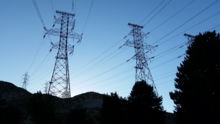
Back Kragoorbrenging Afrikaans نقل الكهرباء Arabic Tresmisión d'enerxía llétrico AST Elektrik veriliş xətti Azerbaijani Пренос на електрическа енергия Bulgarian বিদ্যুৎশক্তি সঞ্চালন Bengali/Bangla Xarxa de transport d'energia elèctrica Catalan Elektrická přenosová soustava Czech Transmisio de elektra energio Esperanto Transmisión de energía eléctrica Spanish
This article has multiple issues. Please help improve it or discuss these issues on the talk page. (Learn how and when to remove these messages)
|

Electric power transmission is the bulk movement of electrical energy from a generating site, such as a power plant, to an electrical substation. The interconnected lines that facilitate this movement form a transmission network. This is distinct from the local wiring between high-voltage substations and customers, which is typically referred to as electric power distribution. The combined transmission and distribution network is part of electricity delivery, known as the electrical grid.
Efficient long-distance transmission of electric power requires high voltages. This reduces the losses produced by strong currents. Transmission lines use either alternating current (AC) or direct current (DC). The voltage level is changed with transformers. The voltage is stepped up for transmission, then reduced for local distribution.
A wide area synchronous grid, known as an interconnection in North America, directly connects generators delivering AC power with the same relative frequency to many consumers. North America has four major interconnections: Western, Eastern, Quebec and Texas. One grid connects most of continental Europe.
Historically, transmission and distribution lines were often owned by the same company, but starting in the 1990s, many countries liberalized the regulation of the electricity market in ways that led to separate companies handling transmission and distribution.[2]
- ^ "Grand Coulee Powerplant". U.S. Bureau of Reclamation. Archived from the original on April 29, 2014. Retrieved March 11, 2015.
- ^ "A Primer on Electric Utilities, Deregulation, and Restructuring of U.S. Electricity Markets" (PDF). United States Department of Energy Federal Energy Management Program (FEMP). May 2002. Archived (PDF) from the original on October 9, 2022. Retrieved October 30, 2018.